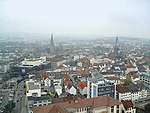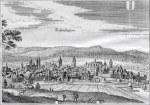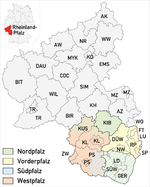Palatine Transmitter
Buildings and structures demolished in 1945Buildings and structures in KaiserslauternDemolished buildings and structures in GermanyRadio communications stubsRhineland-Palatinate building and structure stubs ... and 1 more
Towers completed in 1926
The Palatine Transmitter (German: Pfalzsender) was the first broadcasting station in Kaiserslautern, Rhineland-Palatinate, Germany. It was built in 1926 and used an antenna, which was spun between two 60 m tall free-standing lattice towers, 130 m apart. The towers were made of wood and were the tallest wooden structures ever built in Palatine. The transmitter, which worked on 1429 kHz with a power of 500 watts, mainly broadcast regional news, as well as news from the "Reichssender" in Berlin. In 1945 the towers were demolished by the retreating German troops, although the transmitter building survived and now houses now a day care centre.
Excerpt from the Wikipedia article Palatine Transmitter (License: CC BY-SA 3.0, Authors).Palatine Transmitter
Am Nussbäumchen, Kaiserslautern Kaiserberg
Geographical coordinates (GPS) Address Nearby Places Show on map
Geographical coordinates (GPS)
| Latitude | Longitude |
|---|---|
| N 49.4572 ° | E 7.7723 ° |
Address
Am Nussbäumchen 1
67657 Kaiserslautern, Kaiserberg
Rhineland-Palatinate, Germany
Open on Google Maps








